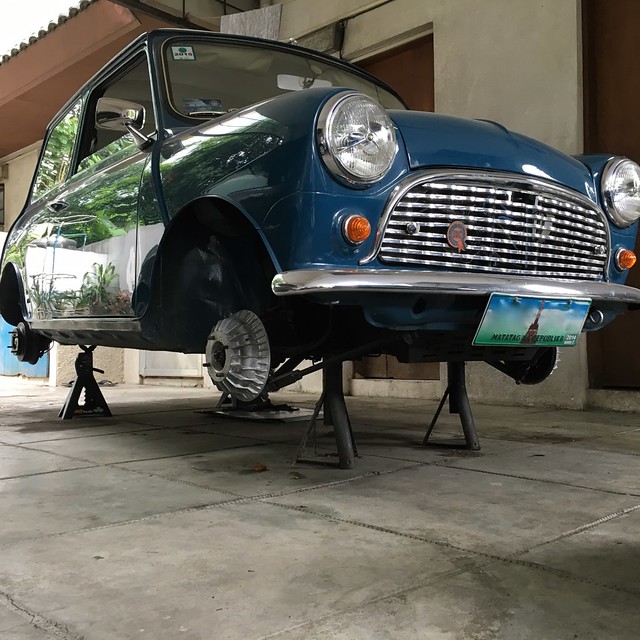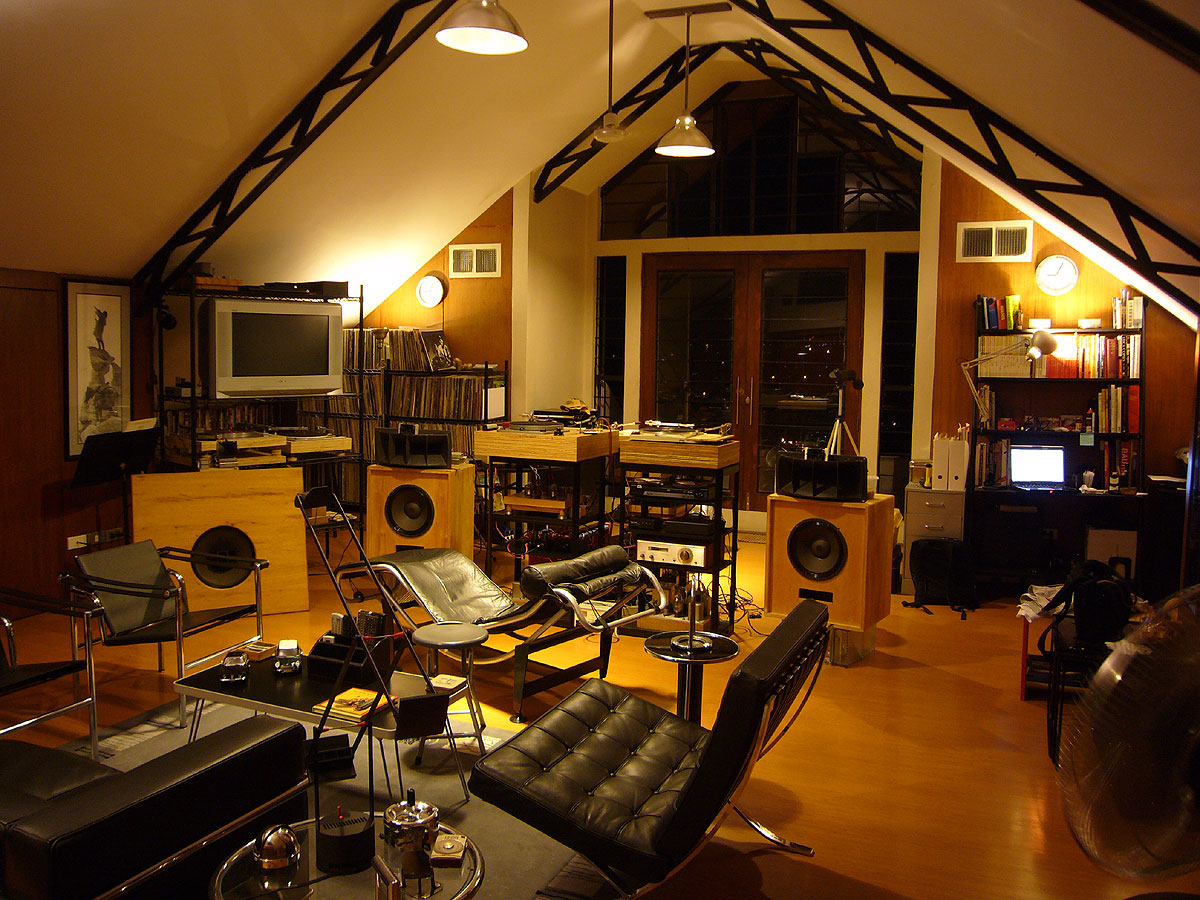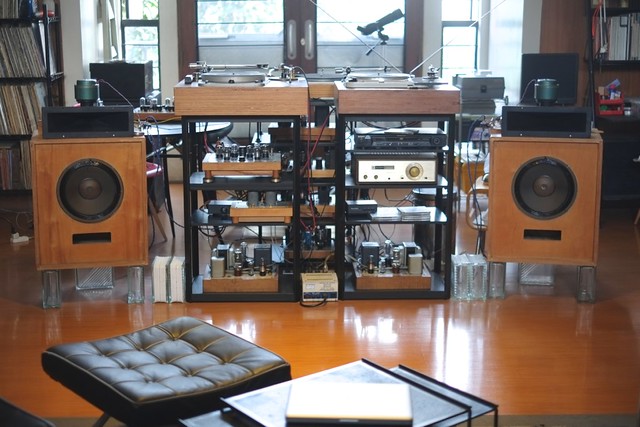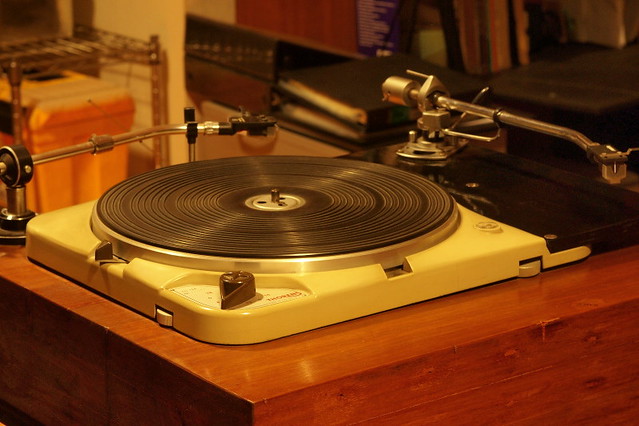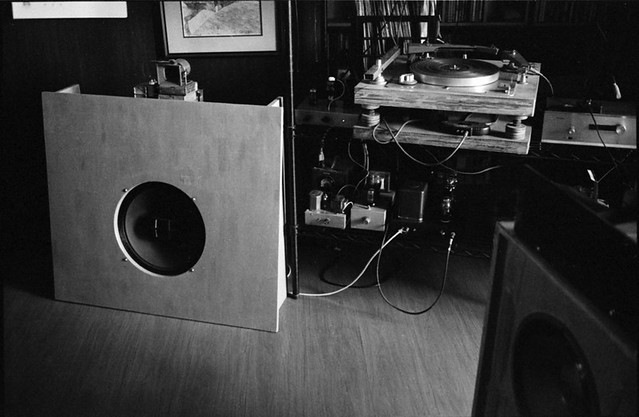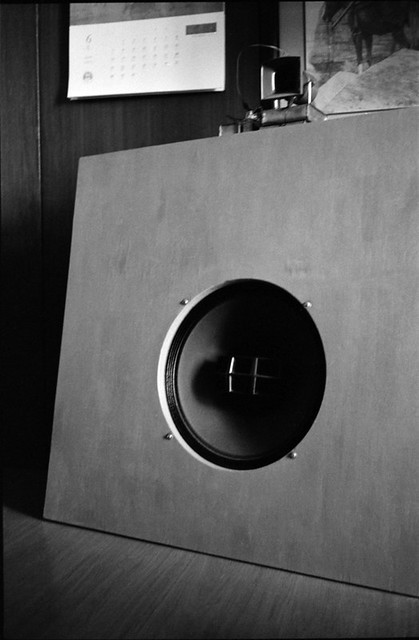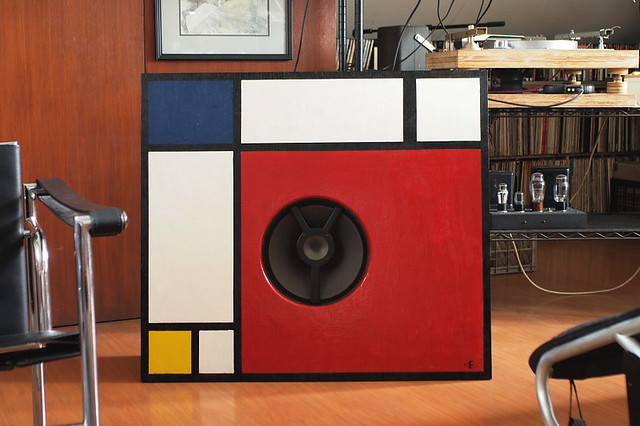Saturday, April 30, 2016
Saturday, April 9, 2016
Stereo > Mono Line Level Mixer - ***Revised 4/12/21***
Mixing line level stereophonic signals into full dimensional monophonic ;)
Here's a DIY project for mono aficionados that's so basic, I should have uploaded it many years ago. But other things got in the way.
Just like an MC step-up, these are entirely passive devices.
The simplest way to convert stereo to mono is to connect left and right channels via a Y connector. But there's a more elegant way than just shorting two channels.
Resistors can blend two signals into one better by...
...using Allen-Bradley carbon composition for warmer sound ;)
Line Output Transformers
This single UTC A-20 transformer was in a box lot of tubes and parts I picked up at a radio show. It's a high quality transformer designed for mic, mixer or line matching applications. Instead of trying to find a mate for MC step-up duty, I repurposed it for a greater calling in my mono rig.
Left and right channels from a stereo source are fed into each primary winding. The summed mono output is taken from the series-connected secondary winding, which goes into the line level input of a mono preamp.
The Covid 19 lockdown was a good opportunity to reassess past projects.
I realized that my original practice of connecting the left and right stereo channels to the split primaries of a single UTC A20 line transformer was sonically inferior to the 2 x Tamura line transformers with their secondaries connected in series as shown above.
The classic UTC A20 and A21 are still very fine contenders but two are needed instead of one. Use the specs above as a guide for hunting transformers under the radar.
If you prefer modern transformers, I highly recommend contacting dave slagle of Intact Audio. He winds fine sounding transformers to spec using high quality materials.
He generously provided the following technical explanation as to why my original recommendation was flawed.
- if the L & R outputs share the same core they are effectively in parallel even if the secondaries are connected in series
- if the L & R are on discrete cores and the secondaries are in parallel the circuit can be drawn as one channel driving the other through two transformers
- if the L & R are on discrete cores and the secondaries in series then the load is also part of the series circuit so a high impedance is reflected back
Subjectively, using a single transformer I heard truncated frequency extremes, compressed dynamics and less detail. With two transformers the sound was cleaner and more articulate with more extension at frequency extremes. Dynamic nuances at micro and macro levels improved significantly. There's also a greater sense of space and ambience!
Wednesday, March 9, 2016
1" compression drivers - Emilar, Renkus-Heinz and Beyma
Is there life after Altec?
My first encounter with Emilar and Renkus-Heinz was in a discussion at the Lansing Heritage forum in 2006. Apparently, Jonas Renkus was a principal at both companies in the 70s and 80s. Prior to co-founding these companies, he worked under John Hilliard at Altec Lansing and followed him at Ling Temco Vought (LTV) where they developed a new compression driver with a polyimide suspension aluminum diaphragm. A paper on this research was submitted to the Journal of the Audio Engineering Society in 1966. This association piqued my interest, which triggered my search for affordable Emilar and Renkus-Heinz drivers.
Soon after I arrived in Manila, I became friends with artisanal speaker craftsman Lin Gomez. He is the go to person for Altec, JBL, Jensen, Western Electric or any vintage driver that needs restoration. His company used to be the official Beyma importer. During his closeout sale of Beyma inventory, among those I purchased was a pair of Beyma CP380M.
For the past couple of years, I've been playing with these drivers in the attic mounted either on the Altec 811, RCF H3709 and Altec 32C. But all of my recent critical listening was done through the mono rig driving one side of the Altec 2-way using the following crossover set up.
Crossover
 |
| 3khz @ 6dB/octave high pass + HF ATT/EQ for 16 ohm drivers |
To keep things simple, critical listening tests were done with the Altec 414A full range and the above crossover was used for the Altec 802D and Beyma CP380M (both 16 ohms) cutting in @ ~ 3000 hz with a 6dB/octave slope.
 |
| 3khz @ 6dB/octave high-pass + HF ATT/EQ for 8 ohm drivers |
For the 8 ohm compression drivers the above crossover was used and the 414A running full range. The 8 ohm L-pad substituted in place of a 25 or 30 ohm wire wound pot works just as well.
Splitting hairs
For all intents and purposes, these drivers were designed for similar real world applications. Since each manufacturer had their own set of measurement parameters, I deemed the inclusion of driver specifications inconsequential. Anyway, I noted that the minor differences in driver efficiency were well within the shelving range of the attenuator on both crossovers.
My main objective was simply to find out how each compression driver attached to the Altec 32C horn blends with the outstanding midrange performance of the Altec 414A woofer loaded inside the 614 bass reflex cabinet. In an ideal world, the blend should be seamless, with the horn/driver combo just filling in the missing upper frequency harmonic overtones not within the reach of the woofer. |
| Altec 802D 16 ohm original aluminum diaphragm Alnico magnet |
The 802D has been a musical companion for almost 20 years, so I know it very well. Attached to the 32C horn and playing duets with the 414A, they produce a harmonically rich and luscious midrange along with high frequencies that are silky smooth and extended. To my biased ears, it would be difficult to equal the 32C/802D/414A/614/JELN1600CXO quintet, short of a WE757A ;)
 |
| Emilar EC175-8 8 ohm original diaphragm Ferrite magnet |
My first impression of the EC175-8 which lingered all throughout my listening test, was a rich midrange reminiscent of the 802D. Perhaps this was due to its rather subtle presentation of high frequencies which are there, yet not stealing the limelight from the midrange. It's worth noting that this driver has a similar long throat design as the 802D.
 |
| Renkus-Heinz SSD 1800-8 8 ohm original diaphragm Ferrite magnet |
The SSD 1800-8 + 414A was also a coherent combination. But the tonal balance was the antithesis of the EC175-8. The midrange sounded a bit leaner due to more prominent high frequencies. This driver has a short throat/pancake design like the 902-8B below. I wonder if the short throat configuration tends to enhance high frequencies?
Caveat: Based on my internet research, there are no original replacement diaphragms currently manufactured for Renkus-Heinz drivers.
 |
| Altec 902-8B 8 ohm original diaphragm Ferrite magnet |
To make things more interesting I borrowed a pair of Altec 902-8B cherished by my buddy Joel. The sound of this driver is similar to the 802D with the midrange not quite as lush but still vivid and involving. Since it had the best high frequency extension and transient response, the sound was invigorating.
 |
| Top left: Beyma 8 AG/N 8" fullrange Top right: Beyma SM115 15" woofer Bottom left: Beyma CP380M Bottom right: OB experiment ca. '09 |
In early 2009 I experimented with the CP380M + 32C coupled to the 15" Beyma SM115 woofer in an open baffle. I was actually quite impressed by the potential of this combination which was the reason I bought them.
 |
| Beyma CP380M 16 ohm polyester diaphragm Ferrite magnet |
However, in the context of this survey, the CP380M did not fare as well as the other drivers. Although the sound was quite pleasant with good high frequency extension, I was constantly aware of a transition between the 414A and the horn. Perhaps it was really voiced for a Beyma woofer?
Coda
The Emilar EC175-8 and Renkus-Heinz SSD 1800-8 have their virtues and omissions. If their virtues were combined, then we have a true Altec alternative. Yet despite their minor flaws, mounted on the Altec 32B horn, both easily coalesced with the Altec 414A woofer which corroborated their genetic heritage. If I didn't have the 802D, I could have easily lived with either the EC175-8 or SSD 1800-8 with a slight preference for the EC175-8 just because I'm a midrange hedonist;)
With regards to the Altec 802D vs. Altec 902-8B, it boils down to a matter of taste as well as availability and affordability. As for the Beyma, when time permits, I will rehash the OB/SM115 + CP380M/horn experiment and post my findings;)
Happy listening!
Saturday, February 27, 2016
Austin Mini Maintenance Woes
As soon as I got the brakes sorted...
...I had the exhaust leak fixed.
In preparation for the summer heat, I installed the
heater matrix
to function as an auxiliary radiator.
I was about to take out the clutch master cylinder
to clean up the rust, but it was too late.
Now I have to wait a few weeks for a replacement clutch master cylinder ;(
Tuesday, February 9, 2016
Listening Room - JE Labs
Hi-Fi Lounge, late 2008
I started this blog in 2011 and overlooked the fact that I haven't posted details of my systems. Visitors who remember the defunct site will be familiar with most of the components apart from a change in venue.
I started this blog in 2011 and overlooked the fact that I haven't posted details of my systems. Visitors who remember the defunct site will be familiar with most of the components apart from a change in venue.
Stereophonic Hi-Fi
Ortofon RMG309 + SPU GME
SME 3012 + Denon DL103S
SME 3012 + Denon DL103R
Audio Technica ATP12T + Denon DL 103
MC step-up transformers
Altec 4722 + Tamura TKS83
Altec 4722 + Tamura TKS83
Altec 2-way
JEL/N1600C crossover
JEL Mono Playback
GE RPX + Denon DL102
JEL Mono preamp with variable EQ
6SL7 phono + 6F8G line stage
Mono Amps
Left--->Right
JEL SE71A
Hammond 125ESE OPT
JEL SE10dx
Tamura F7004 OPT
JEL SE2A3dx
James 6123HS OPT
Altec 605B Duplex
Mondrian inspired OB + RCA 501S1
After almost 20 years, both systems have traveled half way across the globe with no significant changes apart from a couple of tweaks ;)
JEL/N1600C crossover
Open Baffle, Altec 755As, 755Cs and Altec 755Es are
currently in storage at an undisclosed high security facility ;)
currently in storage at an undisclosed high security facility ;)
Monophonic Hi-Fi
Rek O Kut B12H
Tonearms:
Right - Velvet Touch Viscous Damped
Left - Pickering 190 + GE RPX 78rpm stylus
Back - Argonne AR600 + GE VRII Triple Play
GE RPX + Denon DL102
iPod Nano doing double duty as a digital music server and FM receiver
until I find time to fix my other Dyna FM3 tuner
that served in this system for the past 7 years
until I find time to fix my other Dyna FM3 tuner
that served in this system for the past 7 years
+
signal processor ;)
signal processor ;)
JEL Mono preamp with variable EQ
6SL7 phono + 6F8G line stage
Mono Amps
Left--->Right
JEL SE71A
Hammond 125ESE OPT
JEL SE10dx
Tamura F7004 OPT
JEL SE2A3dx
James 6123HS OPT
Altec 605B Duplex
Mondrian inspired OB + RCA 501S1
After almost 20 years, both systems have traveled half way across the globe with no significant changes apart from a couple of tweaks ;)
Saturday, February 6, 2016
Altec 32C horn redux
Three years ago I replaced the Altec 811 horns with Altec 32C horns in my 2-way speaker system. I think I now have an unscientific explanation as to why I've been enjoying the Altec 32C.
Somewhere along the way I acquired a pair of RCF H3709 horns. I was rooting for these horns because they resemble the Altec 32C but with a straight throat. The RCF H3709 to a much lesser degree, still exhibited some congestion and harshness I found objectionable in the Altec 811 in near field listening. Perhaps a judicious amount of damping applied to the thin walls of the RCF H3709 will significantly improve its performance.
Based on the throat comparison picture above, I attribute the sonic superiority of the Altec 32C in my listening environment to its unconstricted and constant flare throat. But that's just my empirical observation ;)
Joe Roberts had nice things to say about the Altec 32A/B/C at the High Efficiency Speaker Asylum and Audiokarma.
Subscribe to:
Posts (Atom)












